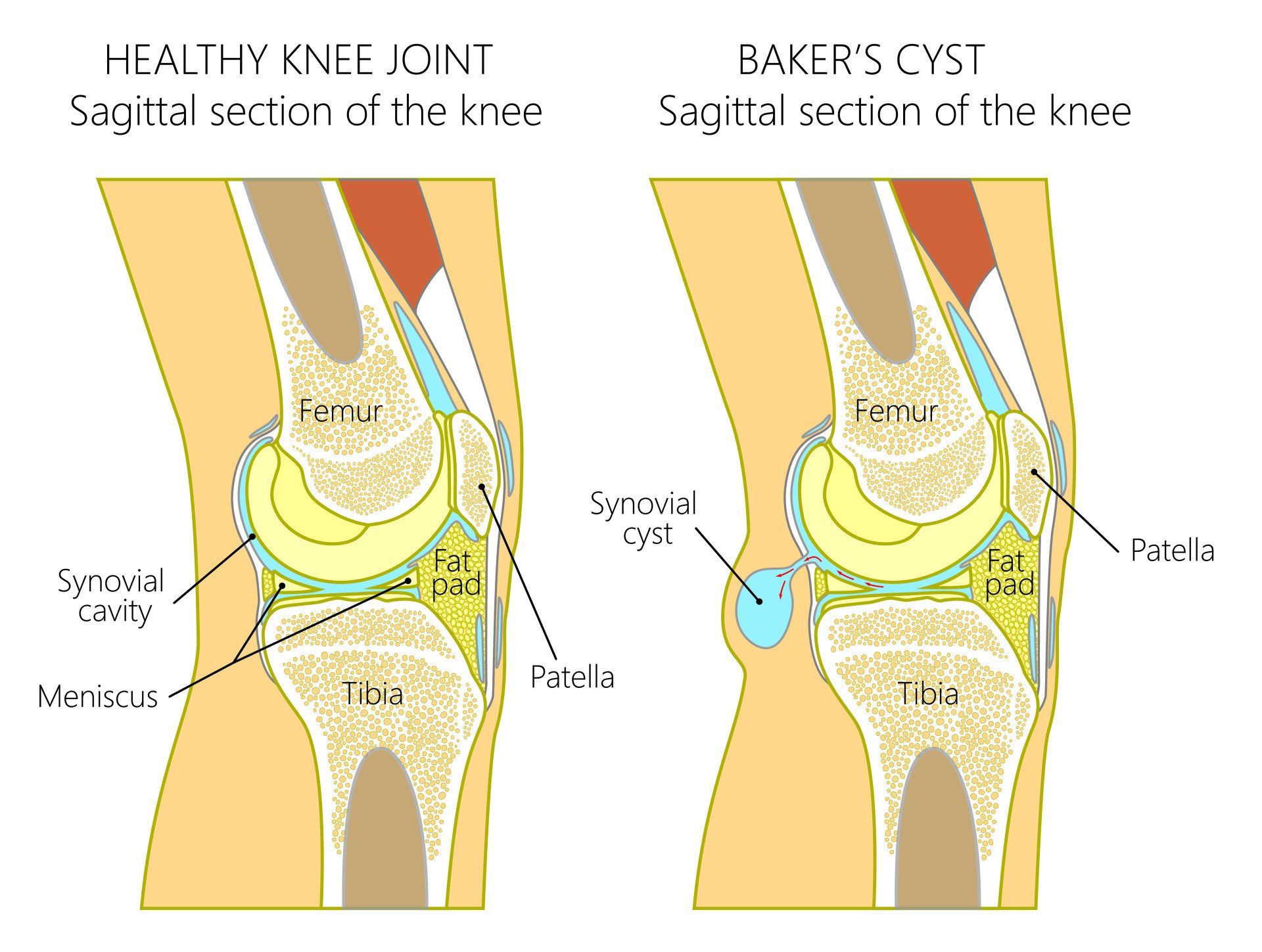Baker’s Cyst
What is a Baker's cyst?
- Baker’s cyst (also called popliteal cyst) is a fluid filled swelling at the back of the knee (popliteal fossa)
- It is an enlarged bursa that is normally located between the medial head of gastrocnemius and semimembranosus although it can be found elsewhere at the back of the knee
- A Baker's cyst communicates with the knee joint cavity
How does a Baker's cyst arise?
- A Baker's cyst is thought to arise due to a one-way valve mechanism:
- As more fluid is produced inside the knee, pressure builds up
- Fluid is then pushed into the Baker's cyst at the back of the knee but can’t get back into the knee joint because of the one-way valve mechanism
- This valve is thought to open during knee flexion and close in extension
- Baker's cyst is secondary to some pathology inside the knee and if this pathology is not corrected, the production of synovial fluid will continue as will the Baker's cyst:
- The body naturally reacts when there is some pathology in the knee (eg torn meniscus, cartilage/arthritis or cruciate ligament) and produces more synovial fluid which is essentially physiological lubricating fluid to overcome the friction
- A
Baker's cysts has a protective effect by releasing pressure inside the knee joint
How common are Baker's cysts?
- Baker's cyst is found in 40% of MRI scans performed on symptomatic knees
- 95% of Baker's cysts are associated with an intra-articular lesion
What are the causes of Baker's cyst?
- Usually due to anything that results in increased fluid inside the knee:
- Osteoarthritis
- Inflammatory arthritis e.g. rheumatoid arthritis, gout
- Knee injury:
- Meniscal tear
- Cartilage lesion
- ACL tear
Presentation
- Baker's cyst can present at any age although more common in those over 40 years
- More common in women as they are more prone in developing arthritis
- Symptoms:
- Diffuse pain at the back of the knee
- Swelling at the back of the knee
- Reduced knee range of motion:
- Especially inability to fully flex the knee
- Tightness at the back of the knee
- Symptoms are made worse after:
- period of activity
- standing for long time
- Size of a Baker's cyst:
- Can vary in size from small asymptomatic to large visible swellings
- As the size increases it puts greater pressure on adjacent structures:
- Pressure on popliteal artery can cause ischaemia
- Pressure on popliteal vein can cause thrombosis
- Pressure on tibial or peroneal nerve can cause peripheral neuropathy with altered sensation in leg
- If the Baker's cyst ruptures can lead to:
- Large swelling in calf
- Intense sharp pain
- Redness in calf
- Often mistaken as deep vein thrombosis (DVT) or muscle sprain/tear
- In such cases a Doppler ultrasound will help provide the definitive diagnosis
Investigations
- Knee X-rays:
- Helps assess presence of arthritis
- Ultrasound:
- Able to detect almost 100% of cases
- Can assess size and location of cyst
- Unable to differentiate cause for the cyst
- MRI:
- Gold standard
- Obtains greater detail of size and location than ultrasound
- Can assess for other knee pathologies that could cause the cyst
- More expensive than ultrasound
Treatment
- Analgesia:
- Paracetamol
- Anti-inflammatories:
- They help to reduce inflammation and swelling in the knee
- Rest:
- This helps to reduce strain on the knee and subsequent swelling
- Ice:
- Frequent icing of the knee helps to reduce inflammation and swelling inside the knee
- Compression with an elastic bandage:
- Wrapping the knee up with an elastic bandage will help reduce knee swelling
- Elevation:
- Elevating the leg will help reduce knee swelling with the help of gravity
- Needle aspiration to drain the fluid:
- Usually performed under ultrasound guidance
- Corticosteroid injection into the knee:
- Helps reduce inflammation and swelling
- Relieves pain
- Does not reduce risk of recurrence
- Baker’s cyst often recurs unless underlying issue is treated such as:
- Arthroscopy to deal with a meniscal or cruciate ligament tear
- Knee arthroplasty to deal with arthritis





